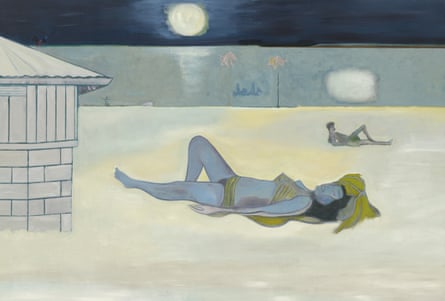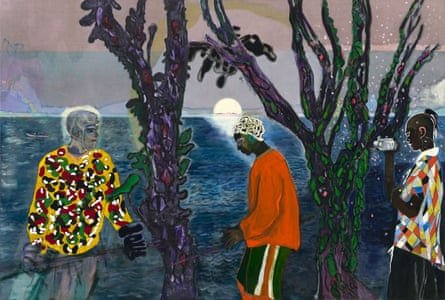‘It could be a massive failure,” says Peter Doig with a laugh. The 63-year-old painter is worrying about his looming show at the Courtauld Institute of Art. Only very rarely is a living artist deemed worthy of having their works hang alongside the esteemed London gallery’s Cézannes, Gauguins, Manets, Monets and Renoirs.
“I know Frank Auerbach showed his building site paintings there,” adds the Scotland-born artist. True, but that was 13 years ago. Since the Courtauld reopened, after a £57m revamp in late 2021, its temporary exhibition space – named the Denise Coates Exhibition Galleries after the billionaire founder of Bet365 – has exclusively hosted blockbuster shows by dead artists. First Van Gogh, then Edvard Munch and most recently Henry Fuseli. Doig will be the first living artist to exhibit there. No pressure then.
Perhaps he shouldn’t worry. After all, say what you like about Van Gogh, Munch and Fuseli, not one of their paintings sold for £5.7m at auction while they were alive. This happened in 2007 when Doig’s painting White Canoe, which was expected to fetch £1m, went for a sum that made Doig, for a while, Europe’s most expensive living painter. Not that he saw the proceeds: the painting belonged to Charles Saatchi. To Doig, the sale seemed a symptom of an art market gone mad, yet it helped establish his reputation while also proving that rumours of painting’s death were exaggerated.

The jeopardy is ramped up further because Doig, an inveterate deadline surfer, hasn’t finished the paintings for the show. At his home-cum-studio in east London, he coughs and splutters his way through the interview, and looks as shattered as anyone who has been up working until 4am would be. He dispatched his second wife, Parinaz Mogadassi, and their three young children on a trip to Paris, so that he could better focus on the eight to 10 paintings he plans to exhibit.
“I’m coughing all the time because of the fumes,” he says. Paint fumes have long been an occupational hazard: Doig’s sinuses are often clogged thanks to the thinners he uses, but working with the studio windows closed during a London winter makes matters worse. “It’s not,” he says, “a very healthy way to go about living.”
Yet on he goes, often working through the night in order to, if not complete his works, then to meticulously make them shine next to the Courtauld jewels – from Seurat’s studies for La Grande Jatte to Cézanne’s bathers and Manet’s A Bar at the Folies-Bergère. “To put your work right next to paintings of that quality and that history is terrifying. You’re there for a beating basically.”
Doig first saw these masterpieces as an art student in London in the 1980s. At the time he was toiling unfashionably at the easel while more eminent young British artists pickled sharks or embroidered tents. “I really enjoyed being a painter,” he says. “I was very happy outside the zeitgeist.” But there was a problem: he felt intimidated by the old masters he so admired. Only when he went on to do a master’s degree, aged 31, at Chelsea School of Art, did Doig make that anxiety work for him. “I had a strange epiphany,” he told me when I interviewed him 11 years ago. “I started making paintings influenced by artists I’d always admired but never dared encroach on.”
This proved his making. In the seminal Milky Way he riffed on Van Gogh’s Starry Night, while Echo Lake self-consciously drew on Munch’s Ashes, in which a woman with red hair holds her hands over her head. But Doig didn’t just find inspiration from long-dead painters. His peripatetic childhood also proved an endless resource. Born in Edinburgh in 1959, he lived in Trinidad from the ages of two to seven, then in Canada until 19. He attended nine schools and never spent more than two years in one home.

Perhaps he should thank his father for catalysing his wanderlust and for the passionate fitfulness that marks his approach to painting. “My dad always had itchy feet,” says Doig. “He was always changing jobs and moving on.” Accountancy was David Doig’s profession but painting was a hobby that followed him like a shadow. “He was a good painter. It was frustrating because he had no real confidence in his work – in the sense that he didn’t really give it the time it merited. When he died, I published a book of his paintings and people were surprised at how interesting they were.”
What did he paint? “Abstracted realities, quite unusual things. He always had a painting, or a few paintings, going. But sometimes he would stop work on one for six months or longer.” Like father, like son, I say. “Very much so. Like me, he was easily distracted.”
after newsletter promotion
Doig’s unfinished paintings, including some for the Courtauld, follow him around the world. “Some I started in New York, others in Trinidad. Often I’d do them in distemper paint, then roll them up and post them to myself, making sure they are fumigated so termites don’t eat through the canvas stretchers. I don’t like finishing things really. I like to have things on the go. Actually, I like paintings where you can question whether they’re finished.” Many of the Cézannes at Tate Modern’s current retrospective are like that, he says. “Some look like they were taken off the easel by someone else.”
Doig enjoys returning to former homelands, especially his beloved Trinidad, which he visited in 2000 on a residency with fellow British painter Chris Ofili. It was supposed to last two months but Doig, along with his first wife, Bonnie Kennedy, stayed for more than a decade. They raised five children there together before separating a decade ago. Kennedy died in 2019.
What was the allure of Trinidad? It’s easy for me to imagine that the Scottish-Canadian – among other things, a painterly poet of snow – found an invigorating sunburst of colour in Trinidad, just as Gauguin and Matisse did while travelling south. “There was something of that,” he says. “But I also had great childhood memories that drew me back. I was a bit anxious about what the reception would be for a white man going back to a former colony. I didn’t want to be a tourist, or a voyeur. A lot of my work questions me, or someone like me, being there.”

That questioning surfaces in Two Trees, one of his best recent paintings. It’s another Trinidadian picture, originally commissioned by the Vienna Kunsthistorisches Museum to sit alongside its works by Pieter Bruegel the Elder, most notably Hunters in the Snow. Like that famous scene, Doig’s painting is dominated by bare-limbed trees, but it goes way beyond the Flemish master’s vision, having been inspired by a view from his window in Port of Spain, the capital of Trinidad and Tobago. Three nocturnal figures stand before the sea, silhouetted by a setting moon like escapees from a Munch fjord.
“To me,” Doig has said, “the painting is about being complicit, being involved in something terrible.” His conceit was that, in looking east through those trees, “you’re looking straight towards Africa. You think about that journey across the ocean, where so many people here came from.” Two Trees incarnates something that has haunted Doig: the problem of a white man engaging with a culture scarred by the slavery other white men visited on Africans. Doig had hoped to show Two Trees at the Courtauld, but sadly it can’t travel from the Met in New York.
Trinidad, despite Doig’s fears, embraced him. “I found people very welcoming,” says the artist, who in turn embraced its culture, falling in love with calypso and soca music. Which brings us back to the Courtauld. Although Doig won’t let me see what he’s working on, an obliging press officer shows me a handful of low-res images depicting works in progress. One features the late, great Trinidadian calypsonian The Mighty Shadow, AKA Winston McGarland Bailey, a recurring figure in Doig’s work, whom he often depicts in his customary costume of skeleton suit, Borsalino hat and guitar slung over his shoulder. Even though The Mighty Shadow was a beloved figure, there is often something sinister in Doig’s portrayals – as if suggesting, as with his canoe motifs, death is at hand.
What drew Doig to the musician? “Shadow was a real voice of the people. He sang about hardship, poverty, life, love. He was very different from other calypsonians. Shadow kept the catchiness while expressing things that made him vulnerable – his stage fright, his shyness. He was such a lovable figure.”
When it comes to painting, Doig is a bit like The Mighty Shadow: self-doubting yet stalwart, embracing tradition yet remaking it on his own terms. I look sidelong at the artist, tired-eyed and sniffly. “The last couple of months before a show are always like this,” he says. “Overwhelming.” He’s not exactly nodding off, but it can’t be long before he does, doubtless while still picking over the massive failure he so fears. Not that there’s much chance of that.

Comments (…)
Sign in or create your Guardian account to join the discussion